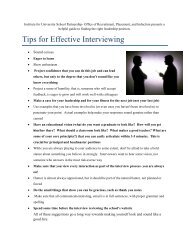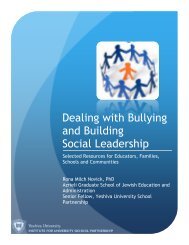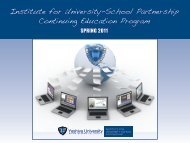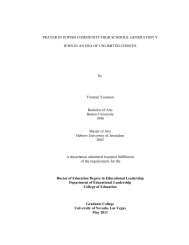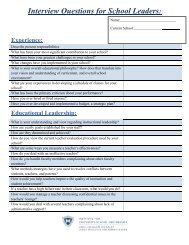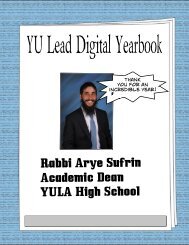Improving Instructional Quality in Jewish Day Schools and Yeshivot ...
Improving Instructional Quality in Jewish Day Schools and Yeshivot ...
Improving Instructional Quality in Jewish Day Schools and Yeshivot ...
Create successful ePaper yourself
Turn your PDF publications into a flip-book with our unique Google optimized e-Paper software.
Research-Based Teach<strong>in</strong>g Practices <strong>in</strong> Curriculum• Underst<strong>and</strong> the Curriculum Development Process –<strong>in</strong>volvesanalysis, design, implementation, <strong>and</strong> evaluation of educationalexperiences <strong>in</strong> a school <strong>in</strong> order to establish goals, planexperiences, select content, <strong>and</strong> assess outcomes of schoolprograms (Wiles & Bondi, 1998, p. 12).• Tripod View of Curriculum –<strong>in</strong>volves three ways of conceiv<strong>in</strong>gcurriculum; based on the needs of the learner, needs of society, orthe knowledge base.• Two Curriculum Models - The Tyler Rationale <strong>in</strong>volves four stepsto consider <strong>in</strong> develop<strong>in</strong>g curriculum. Underst<strong>and</strong><strong>in</strong>g by Design(UbD) has become the most popular approach to curriculumdesign over the past fifteen years.• Plann<strong>in</strong>g, Implement<strong>in</strong>g, <strong>and</strong> Assess<strong>in</strong>g Teach<strong>in</strong>g <strong>and</strong> Learn<strong>in</strong>g -<strong>in</strong>volves a three step curriculum developmental framework.• Design<strong>in</strong>g <strong>Quality</strong> Curriculum –<strong>in</strong>volves three guidel<strong>in</strong>es offeredby Glatthorn (2000a) for design<strong>in</strong>g quality curriculum.Best Practice #1: Be Collaboratively Involved <strong>in</strong> CurriculumLeadershipCurriculum development is a dynamic, <strong>in</strong>teractive, <strong>and</strong> complexprocess that serves as the foundation for good teach<strong>in</strong>g practice.School <strong>in</strong>structional leaders must be actively <strong>in</strong>volved <strong>in</strong> curriculumleadership. Engag<strong>in</strong>g teachers <strong>in</strong> help<strong>in</strong>g develop, monitor, <strong>and</strong> assesscurriculum is best practice (Davis & Krajcik, 2005; Remillard, 2000;Slattery, 2006).Pr<strong>in</strong>cipals, for <strong>in</strong>stance, play a key role <strong>in</strong> engag<strong>in</strong>g teachers <strong>in</strong>discussion about curriculum. They can ask, “What is curriculum?” <strong>and</strong>“How can we take ownership of what is taught?” In do<strong>in</strong>g so, theyencourage teachers to become stakeholders <strong>in</strong> curriculumdevelopment so that they can enrich the educational lives of theirstudents through mean<strong>in</strong>gful <strong>and</strong> relevant pedagogy. Moreover,effective educators set aside school time for curriculum-baseddiscussions <strong>and</strong> allow teachers to creatively develop new curricula.The curriculum is not <strong>in</strong> the textbooks, not <strong>in</strong> worksheets, <strong>and</strong> not <strong>in</strong>58



